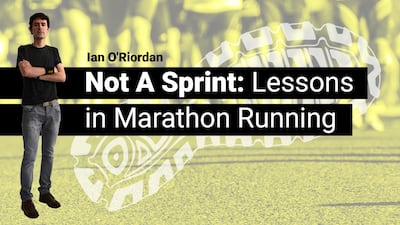All marathon journeys are about reaching your destination: the finish! Continuing here on the first Monday of each month, The Irish Times is running a series of lessons to help make that journey easier and smoother – right to the finish of the 2023 Irish Life Dublin Marathon on October 29th.
Every morning in Africa a gazelle wakes up. It knows it must outrun the fastest lion or it will be killed.
Every morning in Africa a lion wakes up. It knows it must run faster than the slowest gazelle or it will starve.
It doesn’t matter whether you’re a lion or a gazelle – when the sun comes up, you’d better be running.
READ MORE
Somebody, somewhere, once attributed this to Roger Bannister, but no way would a man of his intelligence and, indeed, running prowess have made such a comment about either animal.
Even without his medical grounding Bannister would likely have known that neither gazelles nor lions are up early in the morning: gazelles don’t actually sleep much at night at all, but rather they snooze for a few minutes throughout the day, and lions typically hunt their prey at night. So, gazelles are probably quite safe around lions when the sun comes up.

The marathon runner, however, is an entirely different beast. For a whole variety of reasons, all of them good, the best time to be out running is the morning. Not necessarily as early as sunrise, especially going into the summertime, but even if it’s only once or twice in the week, the payback will be generous.
Every marathon, for one thing, starts in the morning, some earlier than others. Few, if any, afford any sort of a lie in. Given that, at some point you’re going to want to get used to running not long out of bed. Practice certainly makes it smoother, and especially in the long run.
There is another benefit in the energy cycle involved in the marathon. Running first thing in the morning, on a more or less empty stomach – black coffee and a banana the exception, obviously – effectively trains the body to use fat reserves in the burning of energy. An exercise not necessarily in losing weight, but which over time will be a most useful adaptation to completing the classic distance.
Running in the evening is invariably easier, the muscles well warmed up and the heart and lungs too; still, breaking up the routine to make the mornings count, especially if time allows at the weekend, will be another lesson in itself.
Because running in the morning also put the focus on time, not speed, which is the decisive element in the marathon. No one is going to jump out of bed and start running at top speed; or at least they shouldn’t, as this will only force the inevitable onset of oxygen debt.

Marathon runners naturally differ in age, sex, height, weight and innate physical ability, so it’s never wise or even possible to talk about running speed; which is why the better way of coming at it is in terms of running time.
It might be half an hour in the morning, maybe an hour and a half, either way the focus at this point should be on time, not speed. Not yet anyway. Don’t worry about how fast you’re going or how slow you made it back, and running through the motions in the morning is the best way to build up that slow, gradual and sustained conditioning and adaptation process.
Better still, the morning run can better allow you to adjust your speed, depending on how you feel, again knowing it’s all about the time, not the speed. So being slow and stiff at the start is not a bad thing. The single biggest mistake in any marathon is starting out too fast. Sometimes the obsession with speed is hard to ignore, especially with all the gizmos at our fingertips these days. So that slow start to the process fits perfectly with the intended result.
Running in the morning also creates a sense of discipline. If you commit, get out of bed an hour or whatever earlier, complete that run and distance in your own chosen time, it will set you up for a day free of any excuse. Safe to say you won’t pass a gazelle or a lion for that matter, although you might well catch another marathon runner, knowing this is the best part of waking up. After a black coffee in a cup.
DO
Start committing to a running diary. If you are going to stick with any training plan from here on, and take it as seriously as you can, it’s always a good idea to write down each day where or when your run has taken you. Or perhaps not taken you. There will be some inevitable breaks or barren days – holidays, illness, injuries or worse. By writing down the days you have run, how you feel, some record of distance, etc, you can easily look back on how far you have come. Or still have to go.
The running diary won’t necessarily improve your running, or make it any easier. It can provide some further inspiration and motivation, especially after stringing a few weeks together where the progress is all down on paper. Likewise it shouldn’t put you off if gaps appear. This stage of the marathon training should be all about building up a base of fitness and endurance that will allow for the greater specificity of training once required.
DON’T
Get overly focused on a target marathon finishing time. Not at this point. Of course it is important to have a goal – to break three hours, four hours, six hours or just to finish. But the best goals are performance-based, not outcome-based, so the goal for now should be to run to the best of your ability once October 29th rolls around.
Keeping that performance-based goal now is not only easier and more fun; it’s also more realistic. The first question most people will ask anyone who is running a marathon is their target time.
Only closer to marathon Sunday should that become the focus of any question or conversation. By then you’ll have a good idea of what you can run for 10km, for the half-marathon, for 20 miles, and how that will translate into the 26.2 miles, or 42km.
So don’t worry too much about three hours, four hours, etc for now. Start thinking about what you want to target for 10km, or the half marathon, come the summer months. Only when you have those finishing times in your head can any marathon target be realistic.
TARGETS
At some point over the coming months there will be a need to target a countdown race. Not necessarily just yet. Instead the target should be to introduce the “steady run”.
What is a steady run? It’s a run where you up the tempo, not from the beginning but after some distance, then hold the tempo steady. It shouldn’t be too far out of your comfort zone, and should be even-paced, as in strong even-paced.
How long the steady run should be will depend naturally on fitness and progress. Once or twice a week at this point it might be half an hour or a 10km steady run. It should be testing but not breaking, the main point being to find that steady pace you can hold, just out of your comfort zone, and being able to hold it for the desired time.
It takes a little more concentration, and certainly isn’t run at conversation pace, so the steady run is best completed in small groups of one or two. That way there’s less chance of it turning into a race, which the steady run certainly isn’t.





















